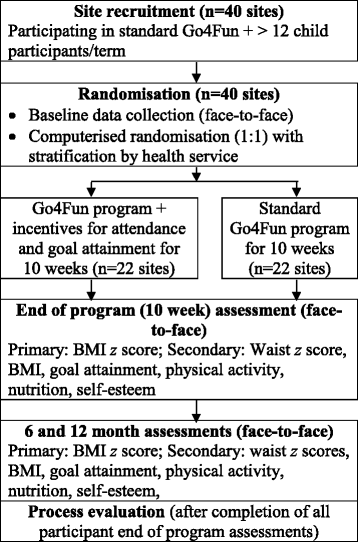Effectiveness of a behavioral incentive scheme linked to goal achievement: study protocol for a randomized controlled trial
- PMID: 26775262
- PMCID: PMC4715870
- DOI: 10.1186/s13063-016-1161-3
Effectiveness of a behavioral incentive scheme linked to goal achievement: study protocol for a randomized controlled trial
Erratum in
-
Erratum to: 'Effectiveness of a behavioral incentive scheme linked to goal achievement: study protocol for a randomized controlled trial'.Trials. 2016 Mar 8;17(1):126. doi: 10.1186/s13063-016-1254-z. Trials. 2016. PMID: 26957296 Free PMC article. No abstract available.
Abstract
Background: Childhood obesity is a concern in Australia and across the world. Community-based weight management programs are an important response to address childhood obesity. However, the scientific literature suggests that their effectiveness could potentially be enhanced by providing a structured incentive scheme. This proposal aims to determine the effectiveness of enhanced goal setting linked to a structured incentive scheme designed to improve the sustained health and wellbeing of overweight/obese children within the context of an existing community-based program.
Methods/design: This study is a cluster randomized controlled trial delivered within the context of the existing NSW "Go4Fun" program with a 10-week and 6- and 12-month follow-up (n = 40 sites, 570 participants) that compares the effectiveness of small changes to the program in which children were asked to set goals (supported by text messages) and were given rewards for achieving them (intervention). This will be compared to the standard/existing program (control), which did not have the same structured incentive program. Data will be collected for all participants at baseline, end of program, and at 6 and 12 months. The primary outcome is a mean change in body mass index (BMI) z score at the 12-month follow-up. Secondary outcomes include anthropometric measures (body weight, height, and waist circumference) and behavioral measures collected via validated questionnaires. A process evaluation (comprising surveys and focus groups) to determine acceptability and sustainability and to inform downstream translation will also be conducted.
Discussion: This study will inform policy and program delivery as well as the broader evidence base regarding goal achievement and incentive schemes directed at children's health-related behaviors and will provide evidence that is likely to be transferrable across a range of health conditions.
Trial registration: ACTRN12615000558527 registered on 29 May 2015.
Figures
References
-
- National obesity taskforce, Department of Health and Ageing, Commonwealth of Australia 2008. Healthy weight 2008 Australia’s future the national action agenda for children and young people and their families. Available at http://www.healthyactive.gov.au/internet/healthyactivie/publishing.nsf/c.... (Accessed 13 Jan 2016).
-
- Australian Bureau of Statistics (ABS). Australian Health Survey: updated results, 2011–2012. ABS cat. no. 4364.0.55.003. Canberra: ABS; 2013.
-
- Summerbell CD, Ashton V, Campbell KJ, Edmunds L, Kelly S, Waters E. Interventions for treating obesity in children. Cochrane Database Syst Rev. 2003;3:CD001872. - PubMed
Publication types
MeSH terms
Associated data
LinkOut - more resources
Full Text Sources
Other Literature Sources
Medical


